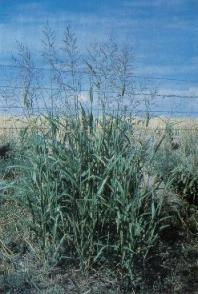Johnson Grass Control Program
 DESCRIPTION
DESCRIPTION
Upright perennial grass, reproduction by large rhizomes and seeds. Well adapted to hold its own in competition with crop plants. Stems up to 6 to 8 feet high or more, from a freely branching, stout, rhizome-possessing, fibrous root system. Leave alternate, simple, relatively wide and long. Spikelets 1-flowered, in groups of three, in rather open large panicles. Fruit a caryopsis or grain, finely striate, reddish-brown. Flowers from May till frost and seed to frost.
PREVENTION OF SPREAD
New infestations of Johnsongrass may be reduced by planting Johnsongrass free seed, using livestock feed that is free of Johnsongrass seed and cleaning machinery before leaving infested fields.
CONTROL PRACTICES
Control of Johnsongrass shall mean preventing the production of viable seed and destroying the plant’s ability to reproduce by vegetative means. Procedures to be used to control Johnsongrass shall include cultural control practices and chemical control or a combination of these two controls.
CULTURAL CONTROL PRACTICES
Cultivation may begin anytime during the growing season and shall be done in such a manner as to cut off all the weed plant at each operation (use duckfoot or blade type implement). Cultivation shall be 3 to 5 inches deep at intervals of 14 to 18 days.
When the plants have been so weakened that they emerge more slowly, the cultivation intervals may be extended to such time as will permit the plants to grow not more than 10 days after each emergence of first plants, but not to exceed intervals of 3 weeks.
Cultivation shall be continued until the weeds have been eradicated or have been suppressed to such extent that remaining plants may be more economically destroyed by the application of approved chemicals to individual plants or by hand cultivation. In yards, flower gardens, lawns and among trees and shrubbery, hoeing and other effective means of thoroughly cutting the weeds at regular intervals of not to exceed 14 days during the growing season shall be construed as intensive cultivation.
A combination of small grains and intensive cultivation may be used. Close grazing or mowing at 2 to 3 week intervals through the growing season and followed by late fall plowing, to expose the root stalks through the winter, is an accepted control practice.
HERBICIDES APPROVED FOR CONTROLLING JOHNSON GRASS
The following herbicides may be used for cost-share with landowners. Other products labeled and registered for use on this noxious weed in Kansas my be used in accordance with label directions but are not available for cost-share. Always read and follow label directions and precautions.
Fusilade (Fluazifop-P-butyl).
Horizon 2000, Fusion (Fluazifop-P-butyl + Fenoxaprop-ethyl)
Plateau (Imazapic).
Roundup
BIOLOGICAL CONTROL PRACTICES
There are no biological controls approved for Johnsongrass control at this time.




